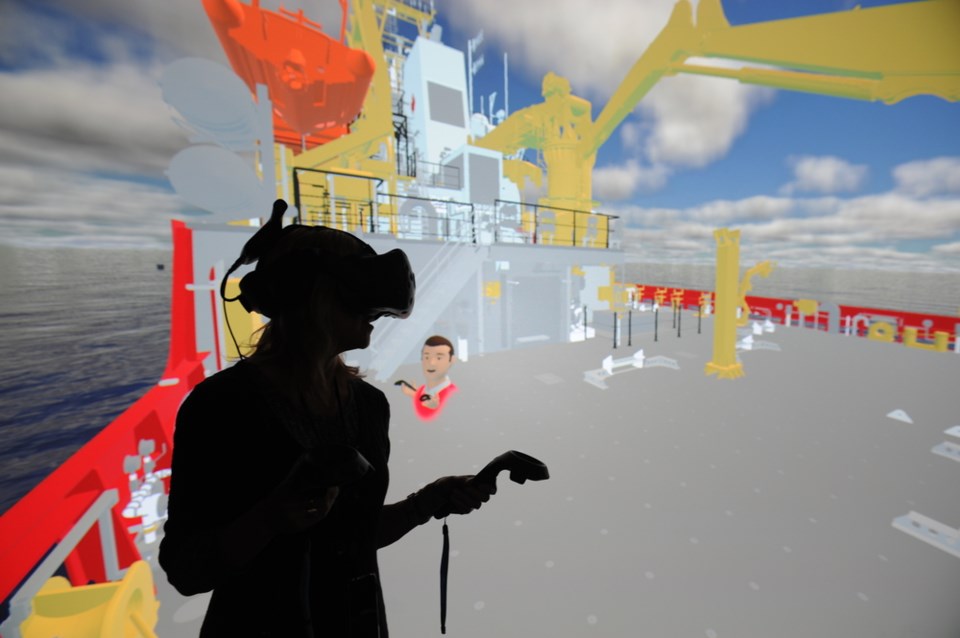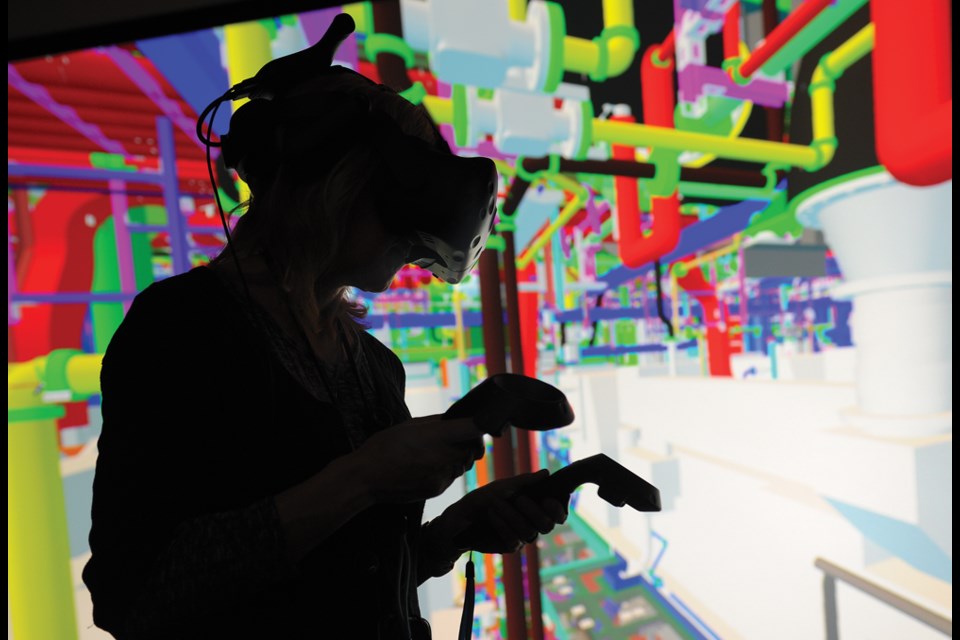Below the deck-house, on the aft deck of the federal government’s new oceanographic vessel, I’m getting my bearings walking carefully between yellow-painted cranes. Beyond the ship’s railings, the horizon where the ocean meets the sky stretches away.
Moving inside the ship, I make a brief stop at the bridge, standing at one of the banks of instrument consoles and observing sightlines from the large windows. Soon, though, I’m down in the heart of the vessel, on a narrow catwalk in the engine room, where a dizzying array of cable trays, electrical systems and water pipes snake above my head.
The most striking aspect of the tour today, however, is that it’s happening on a ship that hasn’t been built yet.
Instead, it’s happening in a virtual reality environment, through both a large-screen 3D immersive experience and a VR headset that are integrated into Seaspan’s new HoloShip platform.
HoloShip brings VR to ship design
The platform, by the visualization company Virtalis, was customized for Seaspan and installed in a dedicated space in Seaspan’s North Vancouver headquarters late last year. It allows ship designers to test out how components fit together and get a much more detailed sense of how a specific feature will work long before any steel-cutting takes place, said Jennifer Busler, Seaspan’s manager of innovation.
“There’s a lot of elements of putting the vessel together that can be very complicated,” said Busler.
Issues like assessing lines of sight, accessibility of certain areas of a ship and arrangements of equipment, in particular, lend themselves to digital tryouts ahead of time, she added: whether a particular catwalk is wide enough or if a member of the bridge crew can see well enough around equipment while docking or navigating ice-filled waters.
Assessing in a digital space first can cut down on costly errors and re-dos, said Busler.
At later stages of the ship’s life, the system can also be used to help guide training, repairs and maintenance.
At Seaspan’s corporate headquarters on the North Vancouver waterfront, the HoloShip’s “ActiveWall” takes up a 5.6-metre immersive display wall. Donning 3D glasses, multiple people can be immersed in the same 3D environment. Off-site partners can also take part remotely.
Space for the 3D theatre room was created by taking out a couple of meeting rooms, needed to house both the theatre and the projector system and behind the systems computer hardware that sits behind the giant screen.
Gamers understand rules of virtual environments
So far, reaction to the visualization system has been positive, said Busler, especially among younger employees. “I find that people who’ve had a lot of gaming experience, they’re very comfortable coming in. They understand the rules of working in a virtual environment.”
Even for those not as adept at virtual reality, “Walking through that vessel is substantially more meaningful than having read just read the reports, or reviewed the engineering material,” she said.
While using 3D visualizations aren’t new to many industries, especially in manufacturing, it’s still relatively rare in the marine industry, Busler added.
Currently the HoloShip program has been used to fine-tune designs for the oceanographic vessel that Seaspan is building for the Coast Guard. The program is also being used in the design process for additional federal ships including the polar icebreaker and a series of multi-purpose vessels.
The oceanographic vessel, which will support scientific research missions, including oceanographic, geological and hydrographic surveys, is currently under construction at Seaspan along with the first of two Royal Canadian Navy joint support ships. The project, which faced several delays, currently has a budget of $966.5 million.






